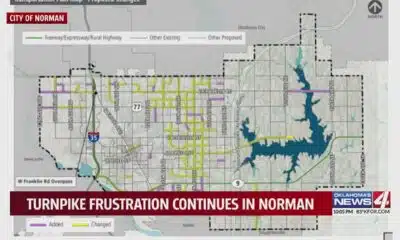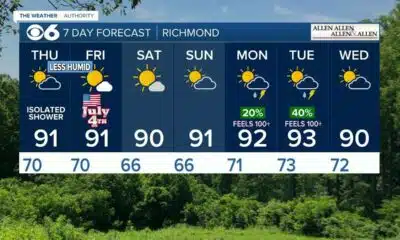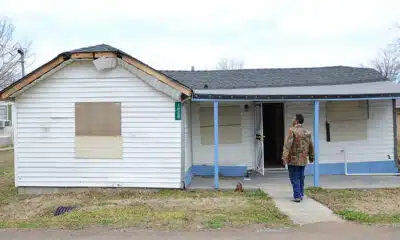News from the South - West Virginia News Feed
FEMA’s refusal to help some West Virginia counties just a taste of what’s to come
by Leann Ray, West Virginia Watch
April 29, 2025
Last week, West Virginia Watch reporter Amelia Ferrell Knisely traveled to McDowell County to talk to residents about recovery efforts after the mid-February floods.
She found that many people still have soggy carpets and wet basements after more than two months. Houses are filled with mold. Trash is piled up outside. Some residents say they haven’t seen anyone from the state or federal government in their small towns offering help.
And McDowell is one of the few counties that actually received federal funding for flood response.
In late February, the federal government approved Gov. Patrick Morrisey’s request for federal aid. The Federal Emergency Management Agency has so far approved nearly 3,500 applications for individual assistance, and more than $25 million has been awarded to residents in Logan, McDowell, Mercer, Mingo, Raleigh, Wayne and Wyoming counties.
Residents who receive that money can use it to cover the costs of temporary housing and home repairs.
About 94% of West Virginia communities are considered “Special Flood Hazard Areas,” which means the more than 84,000 structures in those areas are at a high risk of flooding, according to a 2023 report by researchers at West Virginia University.
However, President Donald Trump has suggested that FEMA, which is the only agency currently that administers disaster relief funds, might “go away.”
Last week it was announced that Elon Musk’s Department of Government Efficiency would cut 1,000 employees — or 20% of the workforce — from FEMA, just ahead of hurricane season.
On Wednesday, Morrisey announced that FEMA denied individual assistance grants to Boone, Cabell, Greenbrier, Kanawha, Lincoln, Monroe and Summers counties, and public assistance grants in Cabell and Kanawha counties for the February floods.
“Despite today’s notification, I am grateful to the Trump Administration for their strong support for Southern West Virginia’s recovery following the February floods,” Morrisey said in a statement.
We know you’re not a native West Virginian, governor, but please stand up for your adopted state.
Alex Brown from Stateline, one of West Virginia Watch’s sister newsrooms, reached out to the White House about states being denied FEMA funding, and received a statement that said the agency is focused on “truly catastrophic disasters,” and that states need to have a better “appetite to own the problem.”
West Virginia has no appetite, as shown during the legislative session.
On April 4, about three weeks after the devastating February floods, Del. Sean Hornbuckle, D-Cabell, proposed adding $50 million to the state budget for flood prevention.
“We have the ability to do something earthly,” Hornbuckle said. “The power that we have — not just the divine power — but with a button and a pen that we all have to help out neighbors in the great state of West Virginia.”
The amendment was rejected 75-19.
Remember the 2016 floods — the deadliest in the state’s history? Former Gov. Earl Ray Tomblin, a Democrat born in Logan County, declared a state of emergency for 44 of the state’s 55 counties.
Since November 2019, FEMA has given West Virginia more than $424 million in funding in response to the 2016 floods. More than $42 million was given to 4,949 individuals and families, and more than $172.8 million was given to local and state governments and some nonprofits. FEMA also provided more than $209.8 million to replace Herbert Hoover High, Richwood Middle, Richwood High, Summersville Middle and to relocate Clendenin Elementary.
Herbert Hoover High School was destroyed, and students were taught in portable classrooms until their new school was completed in fall 2023. Clendenin Elementary School didn’t reopen until fall 2024. Construction hasn’t started on the schools destroyed in Nicholas County.
In response to that flood, the West Virginia Legislature created the State Resiliency Office. Its purpose is to “Minimize the loss of life and property, maintain economic stability, and improve recovery time by coordinating with stakeholders to implement disaster resilient strategies.
The state Legislature created the West Virginia Disaster Recovery Trust Fund in 2023 with Senate Bill 677. The fund sits empty. No money was allocated to that fund during the 2024 legislative session. The FY 2026 budget, which Morrisey has signed, doesn’t include any money for the fund either.
There were only three bills related to flooding during the session — House Bill 2858 and Senate Bill 502 were the same bill, meant to allow counties to regulate floodplains under National Flood Insurance Program guidelines. They both died. House Bill 3502, sponsored by Hornbuckle, would have allowed a one-time allocation of $100 million from the state revenue shortfall fund and $150 million from the state’s income tax revenue fund for the West Virginia Flood Resiliency Trust Fund. It died in the House Government Organization.
West Virginia needs FEMA, but with FEMA potentially out of the picture, it’s time the state whet its appetite and take a bite out of the problem.
Morrisey has already said he plans to call a special session this summer to deal with the Public Employees Insurance Agency and education funding. Sounds like the perfect time and a good use of tax payer money to move some funding over to the West Virginia Disaster Recovery Trust Fund.
GET THE MORNING HEADLINES.
West Virginia Watch is part of States Newsroom, a nonprofit news network supported by grants and a coalition of donors as a 501c(3) public charity. West Virginia Watch maintains editorial independence. Contact Editor Leann Ray for questions: info@westvirginiawatch.com.
The post FEMA’s refusal to help some West Virginia counties just a taste of what’s to come appeared first on westvirginiawatch.com
Note: The following A.I. based commentary is not part of the original article, reproduced above, but is offered in the hopes that it will promote greater media literacy and critical thinking, by making any potential bias more visible to the reader –Staff Editor.
Political Bias Rating: Center-Left
This content reflects a center-left political bias as it highlights government and federal aid shortcomings in disaster response and recovery, particularly criticizing Republican leadership and policies, such as those associated with former President Trump and West Virginia Governor Morrisey. It underscores the need for more proactive state intervention and funding to support vulnerable communities, especially in the context of disaster resilience. The critique of budget decisions and FEMA staff cuts aligns with a perspective that supports stronger public sector involvement and social responsibility, typical of center-left viewpoints, without veering into extreme or partisan language.
News from the South - West Virginia News Feed
Judge says warrants valid in Overstreet case as trial nears for baby's 2021 murder
SUMMARY: Shannon Overstreet, accused of murdering his three-month-old baby Angel in 2021, appeared in Cabell County court as his October trial nears. Prosecutors aim to validate evidence to shorten the anticipated lengthy trial. They presented search warrants from May 2021 covering Overstreet’s homes, car, phones, computers, and Ring camera. Overstreet reportedly purchased suspicious items, including a 55-gallon barrel later found with bone fragments at his Kentucky farm. Angel wasn’t reported missing publicly until May 25th, with Overstreet arrested on unrelated charges before his December 2023 murder indictment. Judge Ferguson ruled the warrants valid but will review Overstreet’s recorded statements before finalizing evidence admissibility.
A man accused of murdering his 3-month-old baby in Huntington and disposing of her body in Kentucky in 2021 was back in court in Cabell County.
FULL STORY: https://wchstv.com/news/local/judge-says-warrants-valid-in-overstreet-case-as-trial-nears-for-babys-2021-murder#
_________________________________________
For the latest local and national news, visit our website: https://wchstv.com/
Sign up for our newsletter: https://wchstv.com/sign-up
Follow WCHS-TV on social media:
Facebook: https://www.facebook.com/eyewitnessnewscharleston/
Twitter: https://twitter.com/wchs8fox11
Instagram: https://www.instagram.com/wchs8fox11/
News from the South - West Virginia News Feed
Christian’s Morning Forecast: Lingering Showers Before Dry Streak Starts
SUMMARY: Storm Watch meteorologist Christian Boler reports lingering showers today with highs near 81°F and cloudy skies in Beckley at 64°F. Winds are light northwest at 5-10 mph. Recent severe weather and flooding are clearing, leading to a dry and pleasant rest of the week and weekend. High pressure will keep the area dry through the July 4th holiday. Temperatures will be near average, with warmer conditions on the coasts and plains, cooler in the southwest. Rain chances return Monday night into Tuesday, with clearer skies Wednesday morning. Overall, a nice stretch of dry weather is expected before next week’s storms.
FOLLOW US ON FACEBOOK AND TWITTER:
https://facebook.com/WOAYNewsWatch
https://twitter.com/WOAYNewsWatch
News from the South - West Virginia News Feed
Flash floods, street flooding impact much of the Tri-State
SUMMARY: Flash floods and street flooding have severely impacted much of the Tri-State area, especially along 4th Avenue near 25th Street in the East End of Huntington. Despite an ongoing sewer project designed to alleviate flooding, heavy rains continue to cause significant water accumulation. The flood mitigation work, intended to reduce future incidents, remains months from completion, making the area vulnerable in the meantime. Nearby Charleston also experiences flooding issues, notably during events like the Sternwheel Regatta on the river. These flooding challenges highlight the urgent need for improved infrastructure and continued prioritization of flood control measures across the region.
Flash floods and street flooding impacted much of the Tri-State on Tuesday afternoon.
For more Local News from WSAZ: https://www.wsaz.com/
For more YouTube Content: https://www.youtube.com/channel/UCrcuU0JXXy8oIBqEB13mrwA
-
Mississippi Today6 days ago
Defendant in auditor’s ‘second largest’ embezzlement case in history goes free
-
News from the South - Georgia News Feed5 days ago
Are you addicted to ‘fridge cigarettes’? Here’s what the Gen Z term means
-
The Conversation6 days ago
Toxic algae blooms are lasting longer than before in Lake Erie − why that’s a worry for people and pets
-
News from the South - Tennessee News Feed6 days ago
5 teen boys caught on video using two stolen cars during crash-and-grab at Memphis gas station
-
Local News6 days ago
St. Martin trio becomes the first females in Mississippi to sign Flag Football Scholarships
-
Local News6 days ago
Mississippi Power shares resources and tips for lowering energy bill in the summer
-
News from the South - Kentucky News Feed7 days ago
Error that caused Medicaid denials has been corrected, says cabinet in response to auditor letter
-
News from the South - Georgia News Feed7 days ago
GOP mega-bill stuck in US Senate as disputes grow over hospitals and more










































